Gloucester
Explore hidden histories, historic photos, and things you never knew about Gloucester from the collections and archives of Historic England.
Discover your local listed buildings and places
Introducing some of Gloucester's most historic sites, included in the National Heritage List for England. Some of these captions have been summarised by AI. Click through for the official List entry. Skip this section and go to place by numbers
Beaufort House
Gloucester
Part of an early C19 terraced row in the Classical style, associated with the Gloucester Spa Company and formerly serving as two houses. In the C21 it is under a single business use.
Governor's House and attached railings, former Her Majest…
Gloucester
Former Prison Governor's House built in c.1850, incorporating the c.1789 tower to the south-east angle of the prison's perimeter wall. There are C20 alterations.
Anglican Church of St Aldate
Gloucester
An Anglican parish church, designed in 1959-61 by Robert Potter (1909-2010) and Richard Hare (1924-1990), with engineering input from EW Gifford and Partners and the Faculty of Engineering,...
64 Westgate Street
Gloucester
Former house, now in commercial use. Late C15 or early C16, with a late C18 or early C19 front elevation. Extensively restored during 1993 to 1994.
Church of St Mark, front wall and gate piers
Gloucester
Parish church, 1846-7. In Early English Gothic style by Francis Niblett for the Diocesan Church Building Association; altered in 1863-4 and 1888-90, the latter by R W Drew.
Christ Church, boundary wall and gate piers
Gloucester
Anglican church. Built 1822-3 by Rickman and Hutchinson; chancel enlarged in 1865; internal alterations and addition of north vestry by Waller, Son & Wood in 1883.
Church of St Lawrence
Gloucester
Anglican Church. C12 nave with C13 north arcade, north aisle and chancel, and C16 tower. The church was restored in the late C19 by Ewan Christian and F S Waller & Son.
Church of St Nicholas
Gloucester
Parish church, redundant since 1971. Early C12; largely rebuilt in C13; with C14 and early to mid-C15 alterations; extended and altered in C16 and C17.
5, 7, 9, and 11 College Street
Gloucester
Row of houses with shops built in the early to mid-C15, probably as a speculative commercial development. C17, C18, C19, and C20 alterations. Read the official list entry to find out more.
Church of St Catharine
Gloucester
Anglican church, built between 1912 and 1915. Designed by Walter B Wood for the Gloucester Church Extension Society in the Free C14 Gothic style, and built by James Byard & Sons.
47 and 49 Westgate Street
Gloucester
Pair of two shops, formerly dwellings and possibly an early conversion of a large townhouse.
14 Westgate Street
Gloucester
Early-C18 house with a shop to the ground floor and accommodation above accessed from a rear stair turret. C15 rear range with a C16 addition. C19, C20, and C21 alterations.
Gloucester Quaker Meeting House
Gloucester
Quaker Meeting House built in 1834-1835 to designs by Samuel Whitfield Daukes with a later two-storey entrance lobby added in 1879 and further single-storey additions in 1946.
66 Westgate Street
Gloucester
Former merchant's house built in the mid-C15. The close-studded elevation of the second floor is mid-C16. C17, C18, and C19 alterations. Late C20 and early C21 repairs.
6 Westgate Street
Gloucester
Formerly a dwelling, this building is now offices and a retail space linked with 8 and 10 Westgate Street (both listed at Grade II) as part of an integrated block of office suites.
55 Westgate Street
Gloucester
Formerly a medieval merchant's house, now a shop and dwelling. It dates possibly to the C15 and has a C17 rear wing.
43 and 45 Westgate Street (the Sword Inn)
Gloucester
Originally two shops with dwellings above, with 43 later becoming an inn; in the late C20 the ground floors were united to create a large public bar.
56 Westgate Street
Gloucester
Formerly a shop and dwelling, then a hotel, now a cafe (2021). The structure dates to the early C19, undergoing late C19 and early C20 alterations for its conversion into a hotel.
War Memorial to the Royal Gloucestershire Hussars Yeomanry
Gloucester
A First World War memorial to the Royal Gloucestershire Hussars Yeomanry, unveiled in 1922, by masons Cash and Wright; with bronze bas-relief panels by Adrian Jones MVO (1845-1938), cast by...
St Michael's Gate
Gloucester
A gateway in the former precinct wall of the Benedictine Abbey of St Peter, dating to the C14 and altered in the early C16. Read the official list entry to find out more.
Scriven's Conduit
Gloucester
A conduit head, dating originally from 1636, carved and moulded in Jacobean style combining Gothic and Renaissance details, relocated elsewhere in the C18 and C19; since 1937, resited in a...
Lower George Hotel
Gloucester
Former merchant's house, now a public house. C16, with C18 and early-C19 alterations. Read the official list entry to find out more.
84 and 86 Westgate Street
Gloucester
Formerly a dwelling, now two shops. Early C19, incorporating an earlier structure of possible C17 date. 84 Westgate Street underwent internal alterations in the early C21.
80 Westgate Street
Gloucester
A shop and former dwelling dating to the early C19 with C20 alterations. It may incorporate an earlier structure. Read the official list entry to find out more.
74 and 76 Westgate Street
Gloucester
Former merchant's house and house, now in commercial use. Number 74 dates to the mid-C15 with later alterations, and has a C15 or earlier cellar.
60 and 62 Westgate Street
Gloucester
Commercial with residential above. Early C19 with number 60 largely rebuilt in 1947, early-C21 alterations. Read the official list entry to find out more.
Outer Gatehouse, former Her Majesty's Prison Gloucester
Gloucester
An outer prison gatehouse, built in 1826 to the designs of the County Surveyor John Collingwood for the County Magistrates, with some C20 alterations.
Perimeter Wall on the east side of the former Her Majesty…
Gloucester
A perimeter wall to the former HM Prison Gloucester, constructed in 1826 to the design ofthe County Surveyor John Collingwood, for the County Magistrates.
30 Westgate Street
Gloucester
Built in the mid-C17 as a shop with accommodation above. Altered and extended in the C19 and C20. The mid- to late-C20 addition to the rear of the building is excluded.
15 Westgate Street
Gloucester
A shop and former dwelling of early-C19 date with C20 alterations. Read the official list entry to find out more.
13 Westgate Street
Gloucester
A shop and former dwelling of mid-C18 date with C19 and C20 alterations. Read the official list entry to find out more.
Quedgeley War Memorial
Quedgeley
First World War memorial, designed by Sidney Gambier-Parry with further names added after the Second World War. Read the official list entry to find out more.
Hucclecote Memorial Cross
Gloucester
First World War memorial, 1920. Later additions for the Second World War. Read the official list entry to find out more.
The Remains of Tanners' Hall
Gloucester
A C13 town house, taken over by the Company of Tanners in 1540 and used as a tannery until the C18, it now (2015) survives as a ruin. Read the official list entry to find out more.
Matson War Memorial
Gloucester
First World War memorial, dedicated in 1920 and designed by F S Waller, architect, with the carvings in the cross head designed by A Maud Parsons, and executed by the sculptor W H Fry.
Church of the Holy Trinity
Gloucester
Anglican church built in 1934 to the designs of Harold Stratton Davies, in a stripped-down C15 Gothic style. Read the official list entry to find out more.
War Memorial in St Swithun's Churchyard
Gloucester
War memorial, early C20, with a later inscription to commemorate those who died during the Second World War. Read the official list entry to find out more.
Explore more
Search for more listed placesGloucester through time
This timeline shows the first period of use for buildings and places on the National Heritage List for England, just one of the details recorded for every list entry. Click around to see how Gloucester changes over time. Skip this section and go to aerial photos
Roman AD 43 to AD 410
Britain was invaded by four legions of the Roman army in AD 43, who relatively rapidly conquered England from landing points in Kent. Parts of Wales and Scotland soon followed.
Roman culture brought urbanism, monumental buildings, wide-ranging religious beliefs, writing, and strong social hierarchy. The Roman administrative system was withdrawn in AD 410.
Early medieval AD 410 to AD 1066
This period, often associated in England with Anglo-Saxons and Vikings, saw a reduction in urban living from the Roman period and increased migration from northern Europe.
Traces of this period can be found in cemeteries, particularly in artefacts and in some of the very early churches, as this period also saw the growth of Christianity in Britain.
Medieval AD 1066 to AD 1540
This period, sometimes known as the Middle Ages, began with the Norman invasion in AD 1066. It saw a significant rise in military and defensive buildings such as castles and earthworks, as well as religious houses dominating a largely agricultural landscape.
The monarchy and Church dominated the period, which also saw the break with the Roman Catholic Church and the English reformation.
Post medieval AD 1540 to AD 1901
The Post-Medieval period brought seismic changes to life in England, with religious reformation leading to the democratization of worship and the destruction of hundreds of religious houses.
In parallel, there was a huge expansion of scientific study and enlightenment that permanently altered the nation's social structure and landscape. Industrialization and mass production lead to wider global trade, emigration, and immigration.
20th century AD 1901 to AD 2000
The 20th century saw an incredible expansion of England's transport networks, with suburban growth shadowing rapid infrastructural expansion. The establishment of state schools, hospitals, and modern technical colleges, with new architectural styles, radically changed the appearance of towns and cities.
Two catastrophic world wars and the 1918 pandemic also brought unprecedented change, altering England's built environment and social structures forever.
Roman AD 43 to AD 410
Britain was invaded by four legions of the Roman army in AD 43, who relatively rapidly conquered England from landing points in Kent. Parts of Wales and Scotland soon followed.
Roman culture brought urbanism, monumental buildings, wide-ranging religious beliefs, writing, and strong social hierarchy. The Roman administrative system was withdrawn in AD 410.
Early medieval AD 410 to AD 1066
This period, often associated in England with Anglo-Saxons and Vikings, saw a reduction in urban living from the Roman period and increased migration from northern Europe.
Traces of this period can be found in cemeteries, particularly in artefacts and in some of the very early churches, as this period also saw the growth of Christianity in Britain.
Medieval AD 1066 to AD 1540
This period, sometimes known as the Middle Ages, began with the Norman invasion in AD 1066. It saw a significant rise in military and defensive buildings such as castles and earthworks, as well as religious houses dominating a largely agricultural landscape.
The monarchy and Church dominated the period, which also saw the break with the Roman Catholic Church and the English reformation.
Post medieval AD 1540 to AD 1901
The Post-Medieval period brought seismic changes to life in England, with religious reformation leading to the democratization of worship and the destruction of hundreds of religious houses.
In parallel, there was a huge expansion of scientific study and enlightenment that permanently altered the nation's social structure and landscape. Industrialization and mass production lead to wider global trade, emigration, and immigration.
20th century AD 1901 to AD 2000
The 20th century saw an incredible expansion of England's transport networks, with suburban growth shadowing rapid infrastructural expansion. The establishment of state schools, hospitals, and modern technical colleges, with new architectural styles, radically changed the appearance of towns and cities.
Two catastrophic world wars and the 1918 pandemic also brought unprecedented change, altering England's built environment and social structures forever.
Aerial photos of Gloucester
Aerial photography helps reveal secrets of England's changing landscapes that are impossible to see from the ground. Skip this section and go to archive images
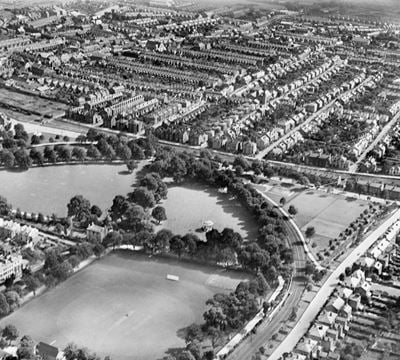
Gloucester
The Park, Gloucester, 1928
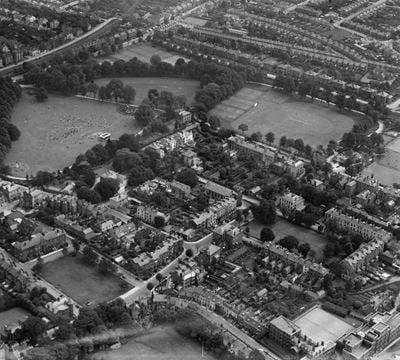
Gloucester
The Park, Spa Field and the city centre, Gloucester, 1936
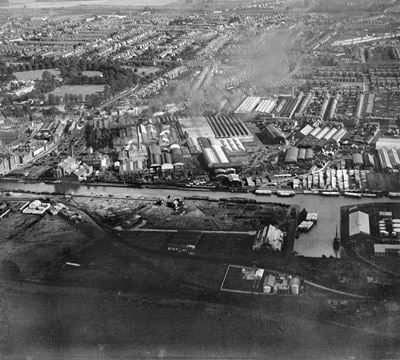
Gloucester
The Gloucester Railway Carriage and Wagon Co Ltd, Gloucester, 1926
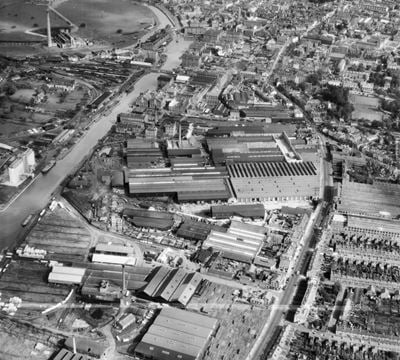
Gloucester
The Gloucester Railway Carriage and Wagon Company Works and environs, Gloucester, 1950

Gloucester
Holy Trinity Cathedral, Gloucester, 1921
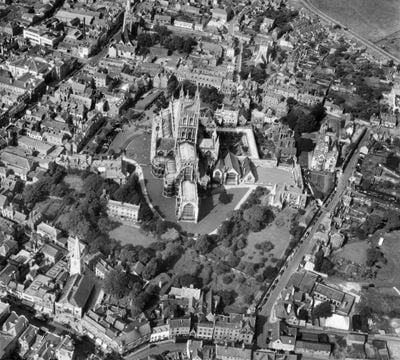
Gloucester
Holy Trinity Cathedral, Gloucester, 1950
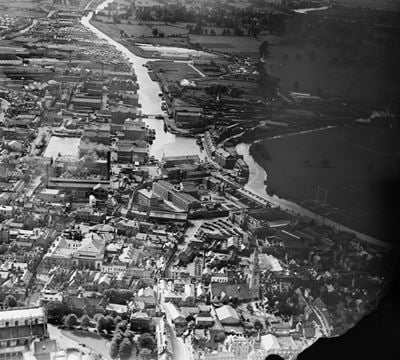
Gloucester
Gloucester prison and the docks, Gloucester, 1928
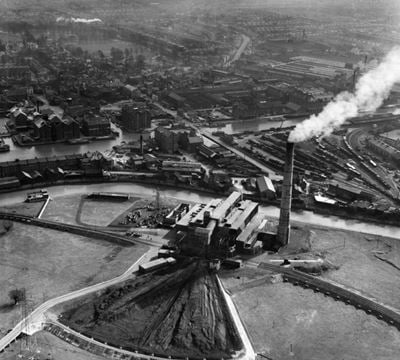
Gloucester
Castle Meads Power Station and the docks, Gloucester, 1949
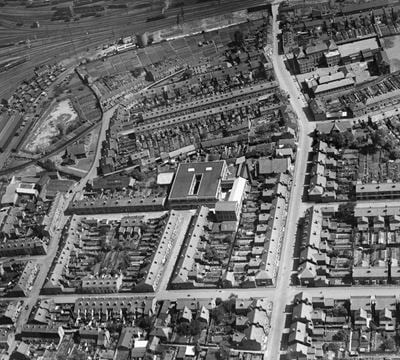
Barton
The Gloucester Shirt Co on Magdala Road and surrounding area, Barton, 1935
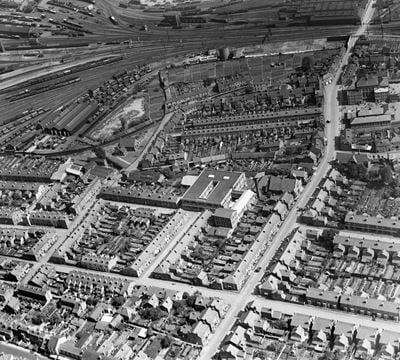
Barton
The Gloucester Shirt Co on Magdala Road and surrounding area, Barton, 1935
Gloucester in the Historic England Archive
The Historic England Archive cares for over 15 million images, dating from the 1850s to the present day. Discover stunning images of Gloucester's past. Skip this section and go to stories about heritage
Eric de Mare
Gloucester, Gloucestershire
Date created: 1956
General view of the Gloucester Docks showing the Sturges Warehouse across the water.
John Gay Collection: Modern Architects
Gloucester, Gloucestershire
Date created: 1970 - 1975
A view of a warehouse housing the VIVO AFD Value Centre in in Bristol Road, Gloucester
John Gay Collection: Counties
Gloucester, Gloucestershire
Date created: 1948
View past the Little Cloister towards the former Infirmary of the Benedictine Abbey of St. Peter, now Gloucestershire Cathedral.
John Laing Collection
Gloucester, Gloucestershire
Date created: 13 Jun 1961
A Wall's Ice Cream van leaving the site of the Wall's Ice Cream Factory, with the Production Block in the background
London, Midland and Scottish Railway Company
Gloucester, Gloucestershire
Date created: 07 Jun 1913
A view showing the north range of the Deanery from Millers Green, with the tower of Gloucester Cathedral visible above the roofline
Alfred Newton and Sons
Gloucester, Gloucestershire
Date created: 1896 - 1920
GENERAL VIEW SHOWING HAY WAINS IN FOREGROUND AND GLOUCESTER CATHEDRAL IN DISTANCE
Nigel Temple Collection of Postcards of Parks and Gardens
The Park, Gloucester, Gloucester, Gloucestershire
Date created: 1900 - 1930
GENERAL VIEW LOOKING TOWARDS THE FOUNTAIN AND SPIRE OF NEIGHBOURING CHURCH
Eric de Mare
Gloucester, Gloucestershire
Date created: 1956
General view of the Gloucester Docks showing the Llanthony Warehouse across the dock.
John Gay Collection: Modern Architects
Gloucester, Gloucestershire
Date created: 1970 - 1975
A view inside the canteen of the warehouse housing the VIVO AFD Value Centre in Bristol Road, Gloucester
John Laing Collection
Gloucester, Gloucestershire
Date created: 23 Feb 1960
Interior view of the water ice mezzanine and water ice area on the first floor of the production block under construction
London, Midland and Scottish Railway Company
Gloucester, Gloucestershire
Date created: 07 Jun 1913
A view looking towards the south-east corner of Miller's Green, showing number 6 and the Deanery, and with the tower of Gloucester Cathedral behind
Nigel Temple Collection of Postcards of Parks and Gardens
The Park, Gloucester, Gloucester, Gloucestershire
Date created: 1900 - 1940
GENERAL VIEW SHOWING FOOTPATH RUNNNG ALONG EDGE OF PARK
Stories about heritage in your local area
Historic England publishes news, blogs, research, videos, and podcasts celebrating England's rich heritage. Discover the stories we have about Gloucester. Skip this section and go to education
What Is the Oldest Pub or Inn in England?
Mentions New Inn, Cathedral Church of the Holy and Indivisible Trinity
Many pubs and inns claim to be the oldest pub in England. Here are the facts.
A Guide to English Gothic Architecture
Mentions Cathedral Church of the Holy and Indivisible Trinity
Learn how to identify the features and characteristics of medieval Gothic architecture in England.
Aethelflaed, Lady of the Mercians
Mentions St Oswalds Priory
Explore the life and work of Aethelflaed, 'Lady of the Mercians'; an Anglo-Saxon ruler who built forts and towns and led armies against the Vikings.
11 Listed Pubs with Fascinating Histories
Mentions Dick Whittington Tavern, 100 Westgate Street
Pull up a bar-stool and get familiar with some of England’s oldest pubs.
The Gallipoli Campaign: 7 War Memorials That Bear Witness to the Great Loss
Mentions War Memorial to the Royal Gloucestershire Hussars Yeomanry
Poignant reminders of the sacrifices made during the Gallipoli campaign of the First World War.
Mentions Gloucester
Join Professor Janina Ramirez for a tour of Gloucester High Street and discover some of the key architectural features found on English buildings from...
Secrets of Gloucester’s Historic High Street with Janina Ramirez
Join Professor Janina Ramirez for a tour of Gloucester High Street and discover some of the key architectural features found on English buildings from the 15th to 20th centuries.
Mentions Gloucester
In the summer of 2023, more than 60,000 people came together for Hi! Street Fest: a series of community-led street parties and carnivals celebrating...
How a Giant Puppet Brought England’s High Streets to Life
In the summer of 2023, more than 60,000 people came together for Hi! Street Fest: a series of community-led street parties and carnivals celebrating England’s high streets.
Introduction to Issue 23
Mentions Gloucester
Claudia Kenyatta, Director of Regions, Introduces this issue on the theme of research into the heritage of England's High Streets.
Grade I Listed Gloucester Townhouse Restored
Mentions Old Judges House, Gloucester
Repairs to the Grade I listed 26 Westgate Street in Gloucester have been completed, aided by a £314,163 grant from Historic England.
The Fleece Hotel, Westgate Street, Gloucester
Mentions The Fleece Hotel, The Fleece Hotel (Part), New Inn
Researching a historic inn to support its conservation and reuse.
High Streets Heritage Action Zone Programme Success Celebrated
Mentions Gloucester
Historic England’s 4-year High Streets Heritage Action Zone programme has unlocked the potential of 67 historic high streets across England.
Grant Awarded to Repair St Michael's Tower, Gloucester
Mentions Tower of the Former Church of St Michael, Gloucester
Historic England has awarded a grant of £137,600 to Gloucester City Council to carry out repairs to a 15th century tower at the heart of the city.
Research Reports Roundup August 2023
Mentions Gloucester
A roundup of recent research reports added to our database in June 2023 to August 2023, displayed by heritage themes.
Seven giant puppets visit Woolwich for Hi! Street Fest finale celebration
Mentions Gloucester
Hi! Street Fest has been taking high streets across England by storm this summer. Now, it returns to Woolwich.
Volunteers Help Reveal Wiltshire's At-risk Monuments
Mentions Gloucester
Local volunteers have helped to bring 2 of Wiltshire's fascinating ancient monuments back into good condition and visible in the landscape once again.
The Context for Researching High Streets Heritage Action Zones
Mentions Gloucester
Senior Investigator Rebecca Lane explains the context of research work that is underway in support of the High Street Heritage Action Zones.
Celebrating the Harold Wingham Collection Through Active Participation
Mentions Gloucester
A collaborative project remembers the work of Harold Wingham, an unsung hero of aerial photography.
Funding Secured for Historic High Streets Recovery
Mentions Gloucester
High Streets across England given the green light for Historic England regeneration schemes to aid their economic recovery.
Buildings Must Be Recycled and Reused to Help Tackle Climate Change
Mentions Gloucester
Recycling, reusing and responsibly adapting our existing historic buildings will help us reach Net Zero by 2050
Gloucester's social history through photos
Over 10,000 images from the Historic England Archive have been specially selected and re-captioned for teachers, students, and anyone who wants to learn more about their local area. Skip this section and go to grant-aided places
Well Cross, Gloucester, Gloucestershire
Period: Medieval (Middle Ages) (1066 - 1484)
This Well Head (cistern) was built to supply water to the Benedictine Abbey of St Peter in Gloucester.
Well Cross, Gloucester, Gloucestershire
Tags
Wall's Ice Cream Factory, Gloucester, Gloucestershire
Period: 1950s (1950 - 1959)
Workers concreting the silberkuhl roof of the production block during the construction of Wall's ice cream factory, Gloucester.
Wall's Ice Cream Factory, Gloucester, Gloucestershire
Theatre De Luxe, Gloucester, Gloucestershire
Period: 1930s (1930 - 1938)
Theatre De Luxe was taken over by the Odeon chain in 1937. The Odeon cinema company was founded in 1930 by Oscar Deutsch.
Theatre De Luxe, Gloucester, Gloucestershire
Sturge's Warehouse, Gloucester Docks, Gloucester, Gloucestershire
Period: Victorian (1837 - 1901)
A group of warehouses seen here across the main basin of Gloucester Docks.
St Oswald's Priory, Gloucester, Gloucestershire
Period: Anglo Saxon (Britons/English/Vikings) (410 - 1065)
These are the ruins of the former Augustinian Priory of St Oswald. It was founded by St Athelflaed in c900.
St Oswald's Priory, Gloucester, Gloucestershire
St Michael's Gate, Gloucester, Gloucestershire
Period: Medieval (Middle Ages) (1066 - 1484)
This is a 14th century pedestrian gateway in the former precinct wall of the Benedictine Abbey of St Peter (now the Cathedral).
St Michael's Gate, Gloucester, Gloucestershire
Ships at Gloucester Docks, Gloucestershire
Period: 1930s (1930 - 1938)
Large sea-going vessels mingle here with barges and tugs; the 'workhorses' of the canals.
Ships at Gloucester Docks, Gloucestershire
Pillar Warehouse, Gloucester Docks, Gloucestershire
Period: Victorian (1837 - 1901)
This warehouse building was probably constructed in 1849.
Pillar Warehouse, Gloucester Docks, Gloucestershire
Discover more
Ready for more local heritage? Take a look at these other places nearby
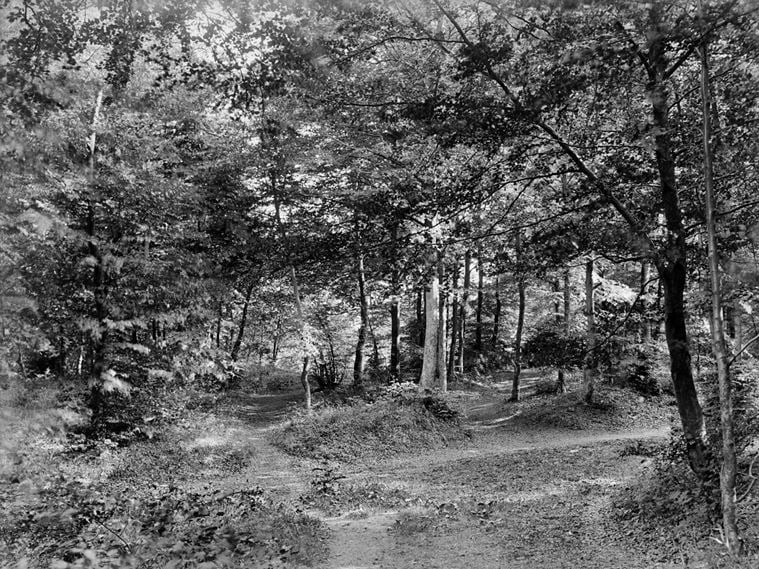
Gloucestershire
Ceremonial County
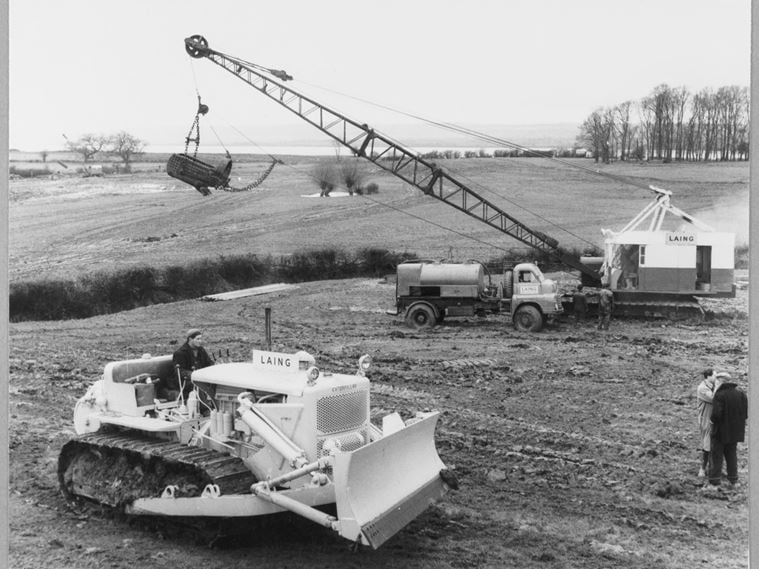
Stroud
Local Authority District
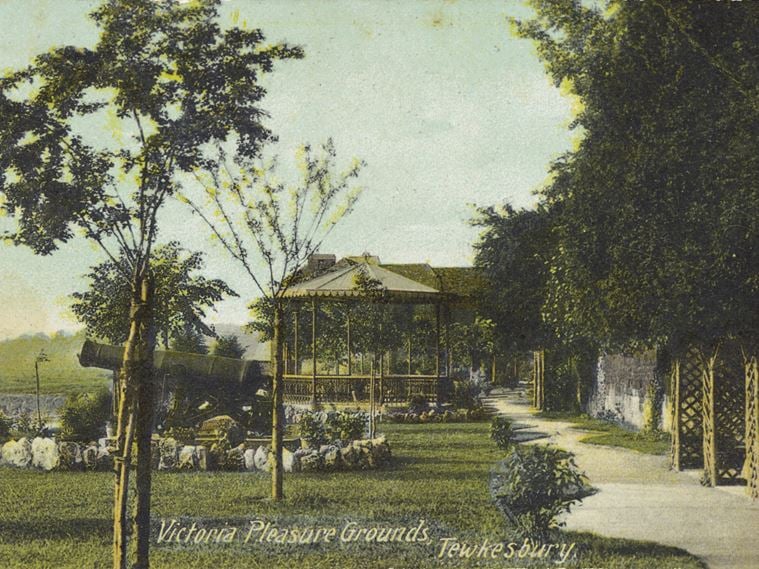
Tewkesbury
Local Authority District